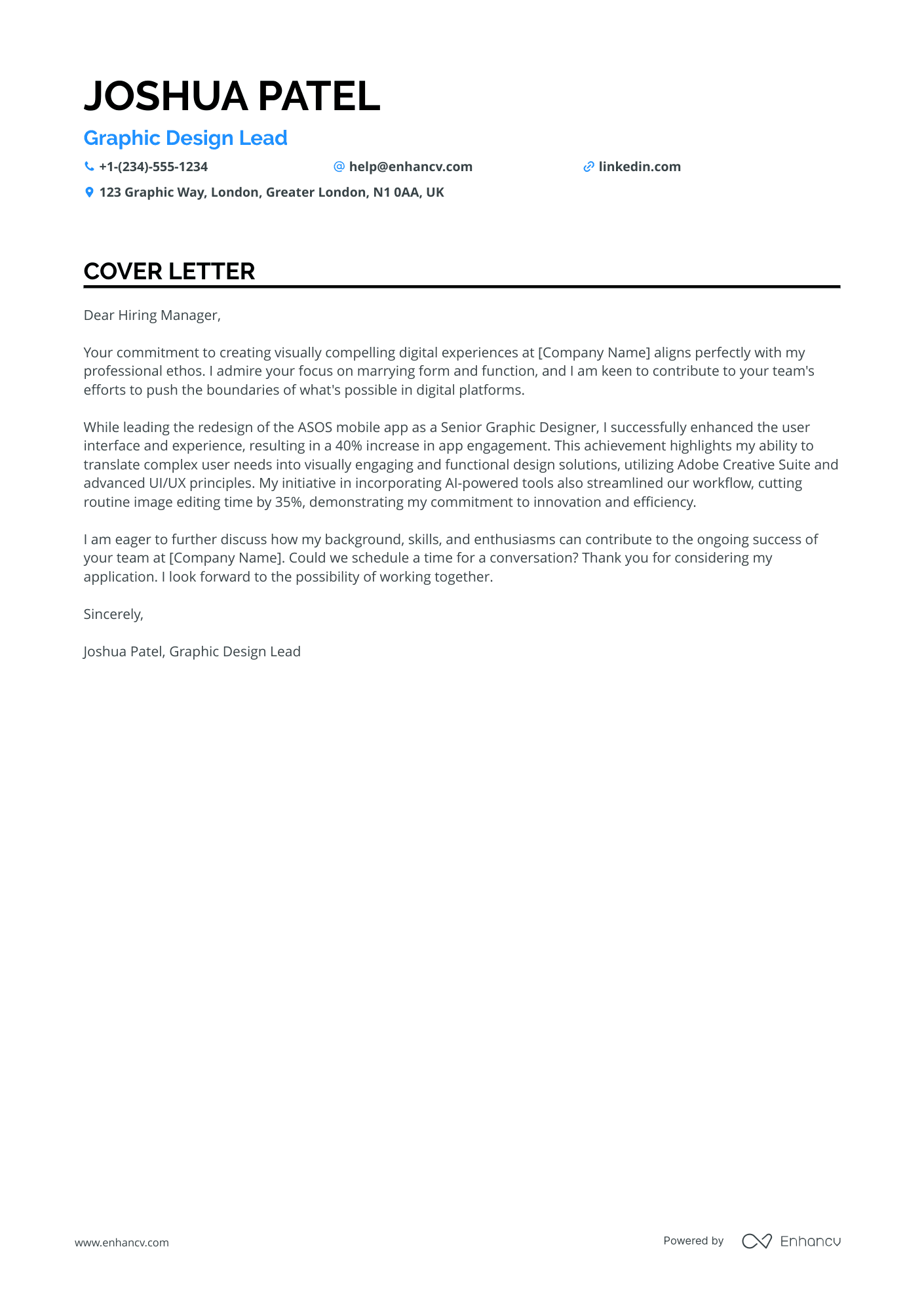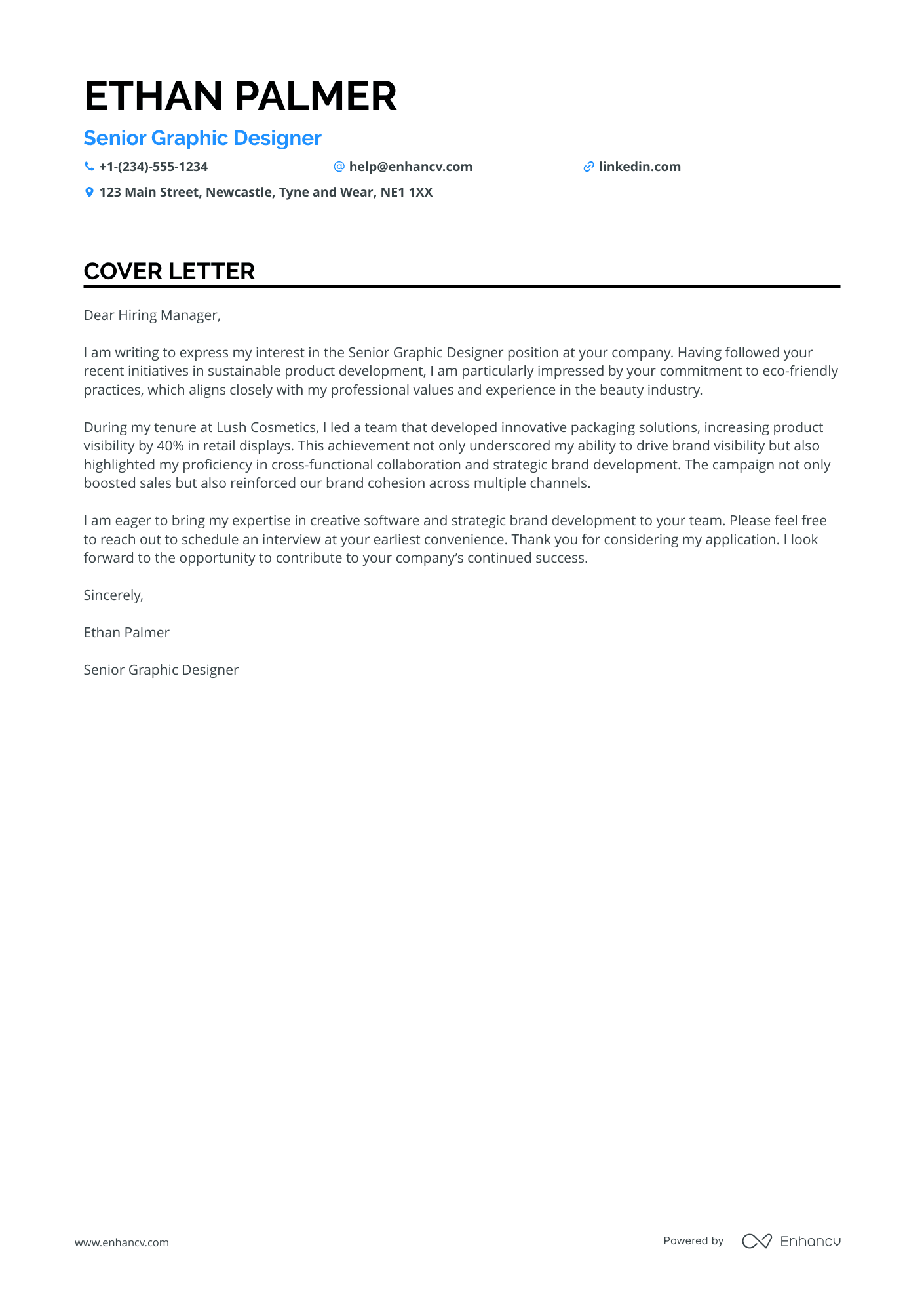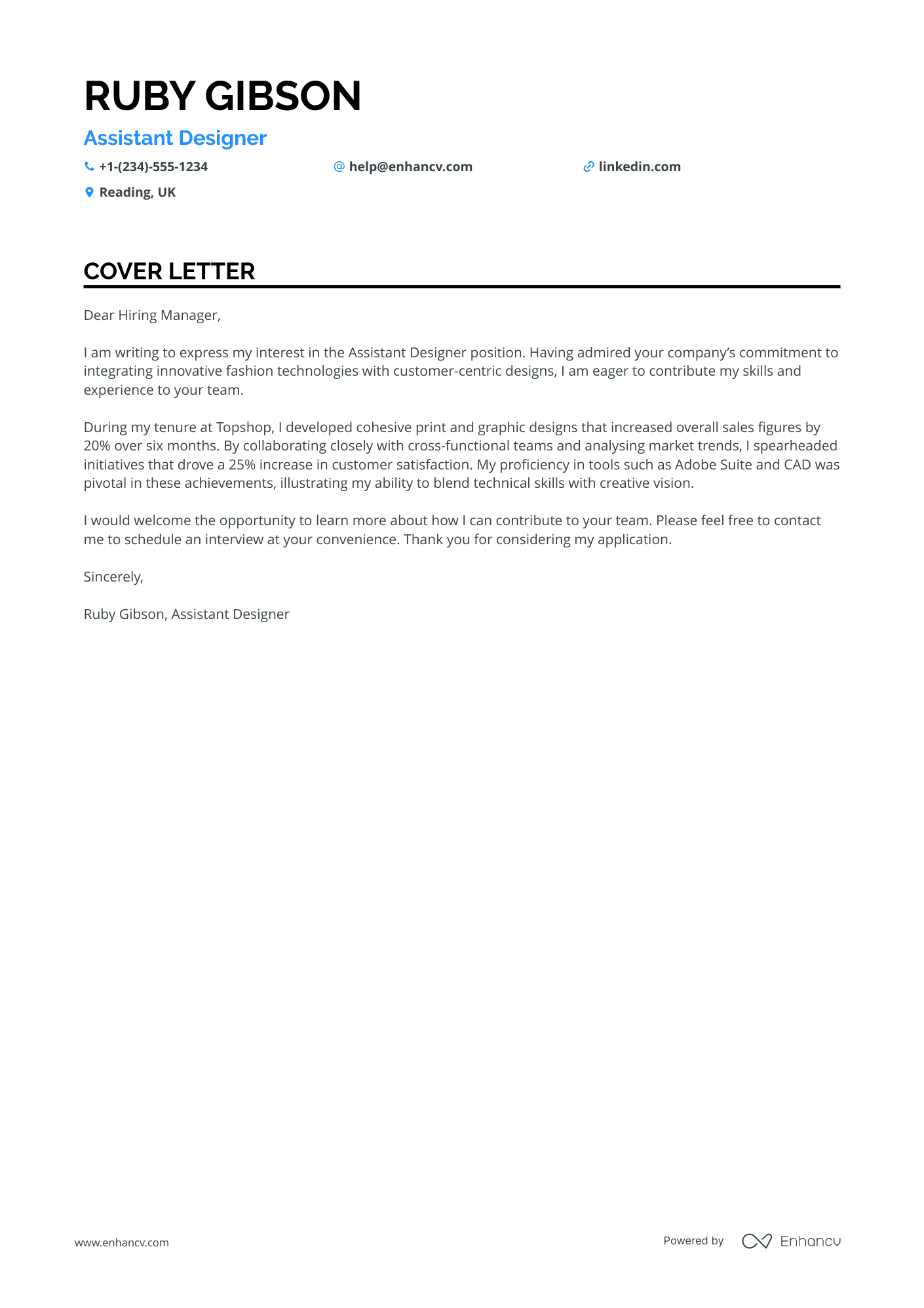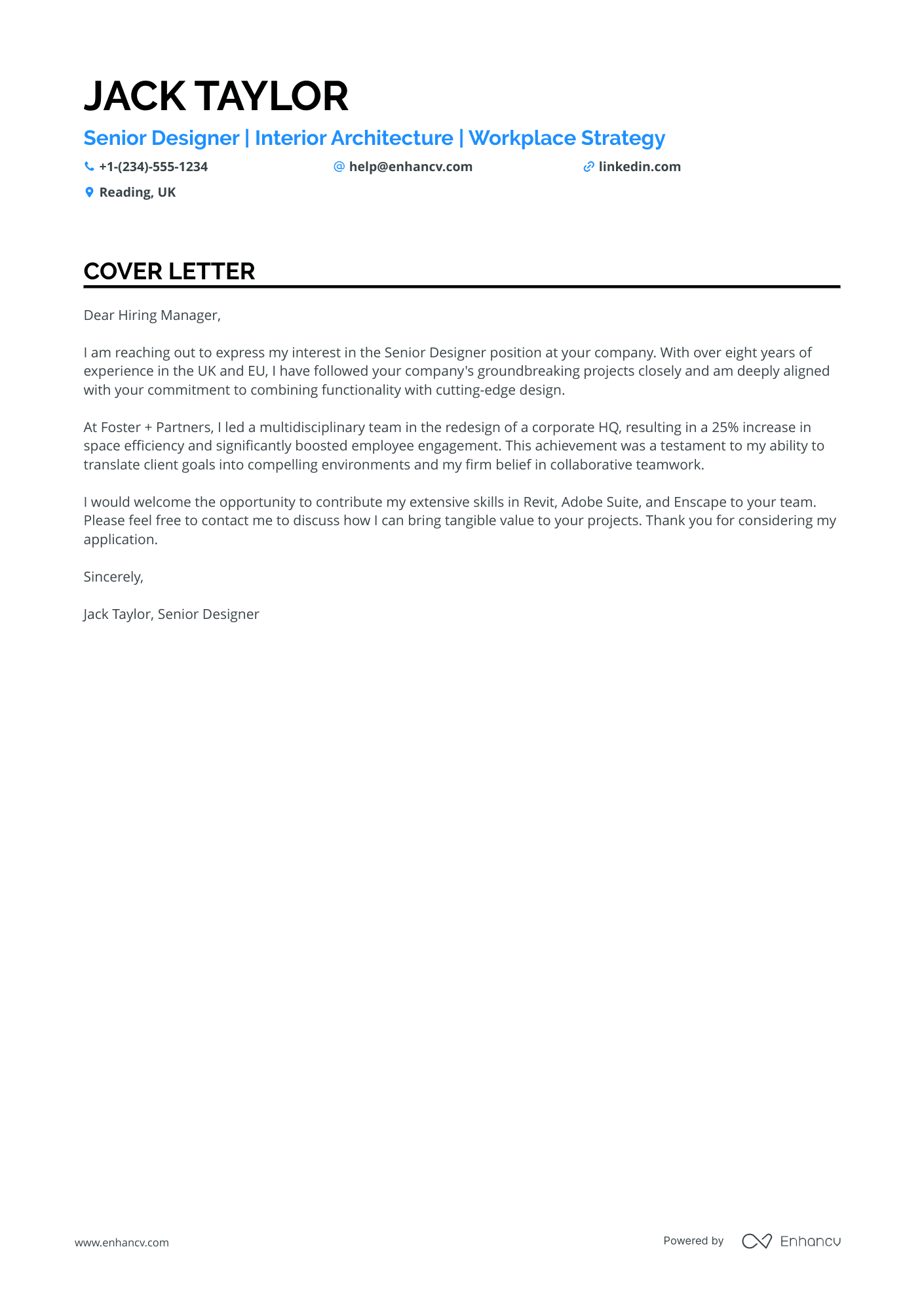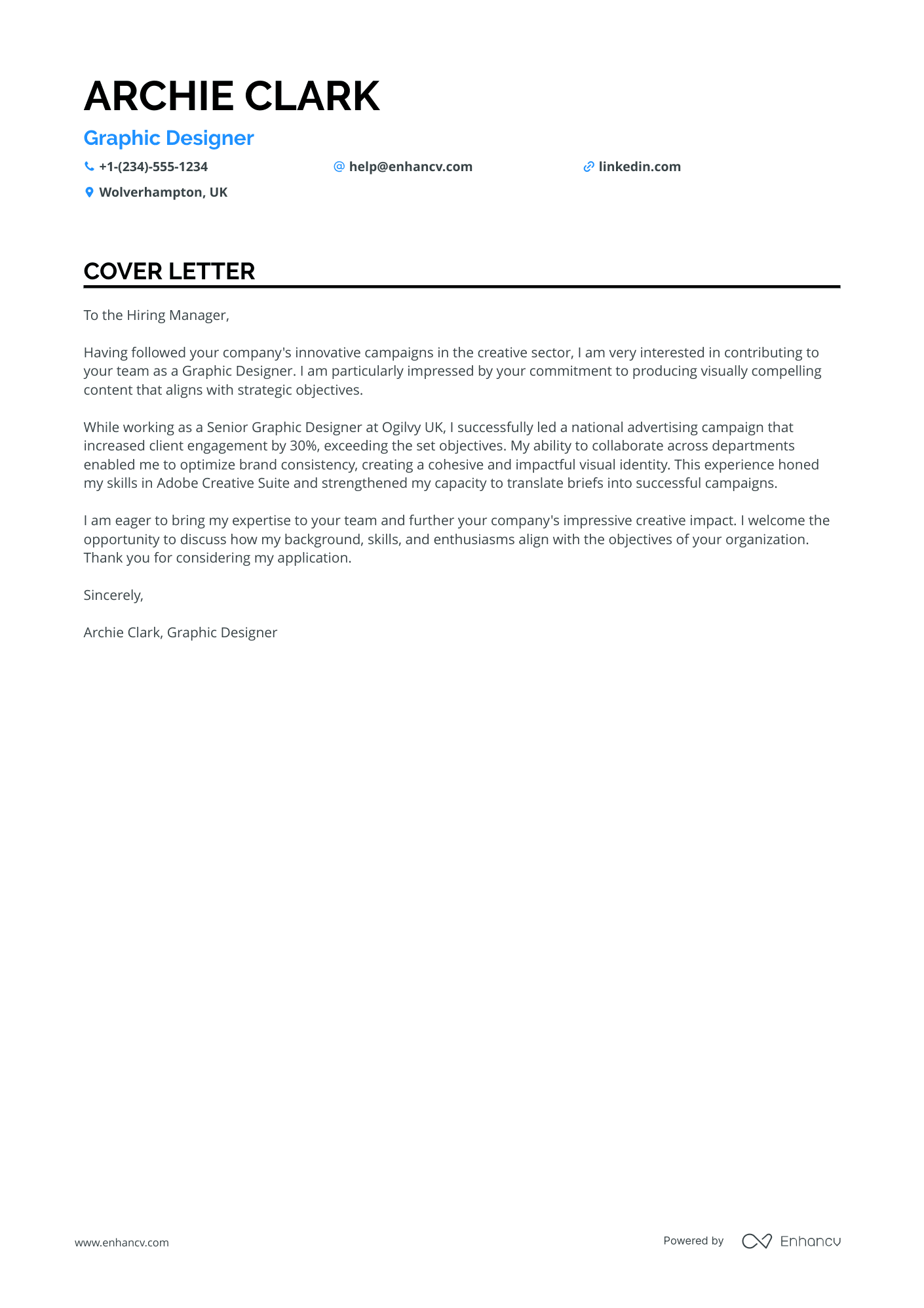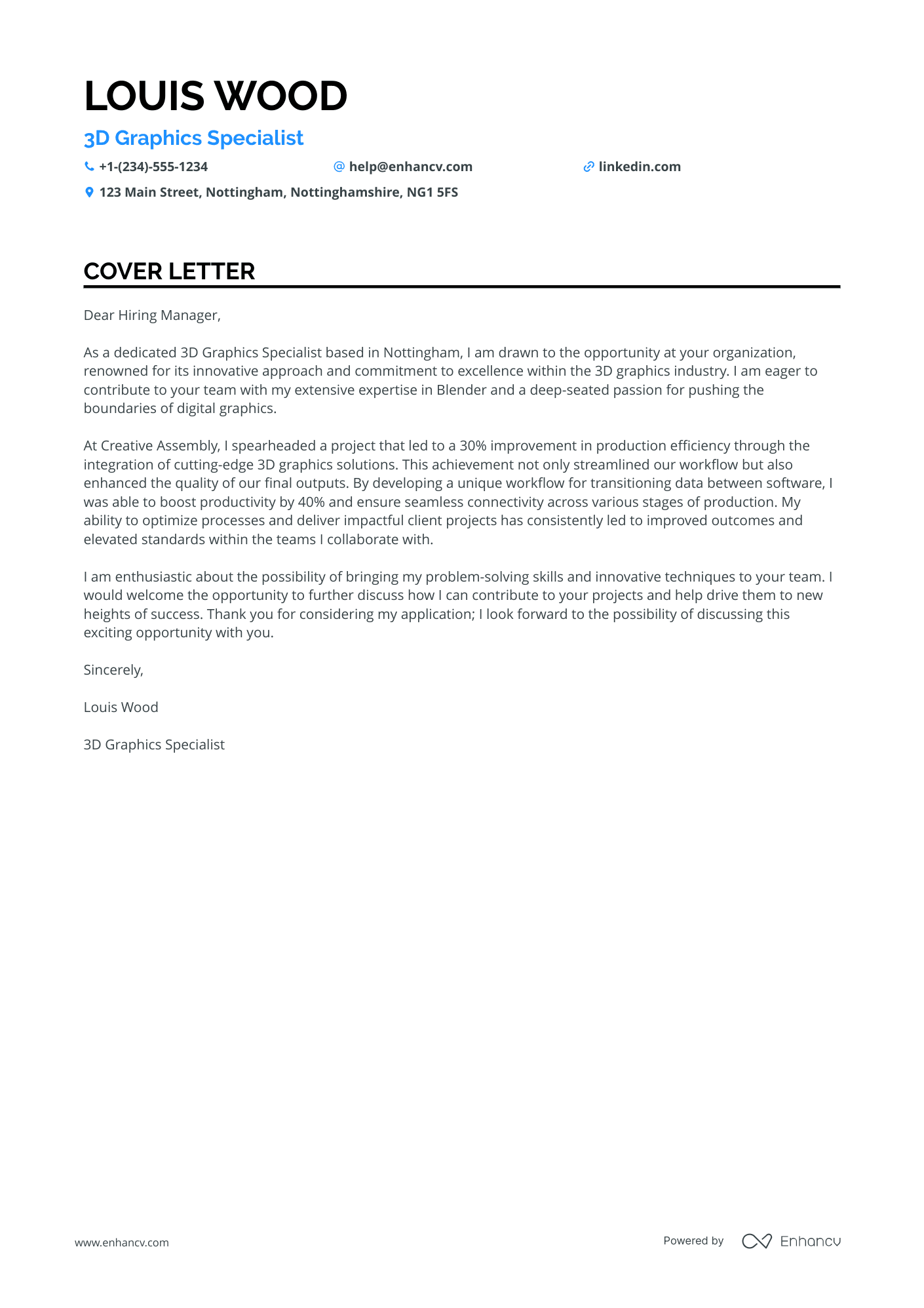Writing a strong cover letter requires close attention to detail, from the tone of voice to avoiding those pesky spelling or grammar mistakes.
Overlooking similar small details can weaken your application.
Many candidates also struggle with how to address the letter, often opting for 'Dear Sir or Madam' when they can’t find the correct contact. This can make your cover letter feel impersonal.
In this guide, we’ll show you how to perfect these crucial elements, ensuring your cover letter is polished and professional without relying on clichés.
Cover letter examples for graphic design
By Experience
Junior Graphic Designer
- Specific Skill Emphasis: The cover letter effectively highlights proficiency in Adobe Creative Suite, a critical skill for a graphic design role, ensuring alignment with the job's software requirements.
- Quantifiable Achievements: Multiple instances of quantifiable outcomes, such as a 30% increase in engagement, provide concrete evidence of the candidate's impact in previous roles, enhancing credibility.
- Experience in Relevant Projects: Demonstrating experience with large scale marketing campaigns and rebranding projects illustrates the candidate's capability in handling significant responsibilities and contributing to high-profile initiatives.
- Educational and Certification Relevance: The inclusion of a degree in Graphic Design and certifications from Shillington Education and Coursera ensures academic credentials that support industry-specific competence.
Senior Graphic Designer
- Experience and Achievements: Highlighting specific achievements such as increasing brand recognition by 30% through innovative campaign designs demonstrates a proven track record in brand development, which is crucial for a Senior Graphic Designer role.
- Relevant Industry Experience: Specific experience in the beauty industry with companies like Lush Cosmetics, ASOS, and The Body Shop underscores your specialisation in the target market, adding value to your candidacy.
- Advanced Skills and Certifications: Emphasising expertise in software such as Adobe Creative Suite and certification in advanced graphic design tools shows proficiency in the essential tools required for high-level graphic design roles.
- Education and Continued Learning: An MA in Graphic Design from the Royal College of Art and additional courses such as Creative Brand Strategies showcases a commitment to both foundational education and continued professional development.
Graphic Design Intern
- Highlighting specific achievements: The cover letter effectively mentions the winning design submission in a university contest and an illustration series published in a local magazine, showcasing recognised talent and contributions to the field.
- Relevant Experience: Tailoring the cover letter to highlight specific experiences with fashion blogs and social media graphic content creation demonstrates a connection to the desired job role.
- Skill-specific trainings: Mentioning completed courses like Advanced Photoshop Techniques and Creative Digital Collage aligns with the skills required for a graphic designer and adds value to the candidate’s expertise.
- Quantifiable Outcomes: Including specific metrics such as percentage increases in engagement and readership offers tangible evidence of the candidate's effectiveness and impact in prior roles.
Entry-Level Graphic Designer
- Highlight Proficiency in Adobe Creative Cloud: The cover letter effectively emphasises William's proficiency in Adobe CC suite, a critical skill for a Junior Graphic Designer, showcasing his ability to handle industry-standard design software.
- Showcase Achievements with Quantitative Metrics: The cover letter employs specific metrics, such as a 30% improvement in brand visibility and a 25% enhancement in campaign engagement, to demonstrate the impact of William's contributions in past roles.
- Emphasise Cross-functional Collaboration: William highlights his experience in collaborating with cross-functional teams, which is an essential aspect for roles that require coordination between graphic design and marketing departments.
- Relevant Education and Training: The cover letter underscores William's comprehensive educational background in graphic design, along with targeted courses like 'Advanced Graphic Design Techniques', indicating his preparedness and commitment to his professional development.
Graphic Design Assistant
- Highlighting Relevant Experience: Ruby's cover letter effectively showcases her experience at notable fashion companies such as Topshop, River Island, and New Look, evidencing her capability in high-traffic environments and her contribution to significant sales and engagement increases.
- Use of Specific Metrics: The cover letter makes use of quantifiable metrics, such as "35% increase in engagement" and "20% reduction in production time," providing concrete evidence of her achievements and impact.
- Relevant Skills and Tools: By listing skills in Adobe Suite, CAD, and trend research, Ruby aligns her skillset with the typical requirements for fashion and design roles, highlighting her competence in essential design tools.
- Passion for Fashion Innovation: Ruby underscores her passion for integrating new technologies into Gen Z fashion, aligning closely with industry trends and demonstrating her forward-thinking approach.
By Role
Graphic Design Specialist
- Highlighting Specialised Skills: The cover letter effectively showcases key skills relevant to the role such as expertise in MS Office and Adobe Creative Cloud, which are crucial for a Desktop Publishing Specialist position.
- Emphasising Achievements: By quantifying achievements, such as increasing client approvals by 30% and improving presentation quality by 40%, the writer provides concrete evidence of their impact, making the application more compelling.
- Detailing Relevant Experience: The cover letter strategically includes experience from previous roles that align with the job, such as developing PowerPoint templates and managing marketing collaterals, demonstrating applicable expertise.
- Mentioning Relevant Certifications: Notably, the inclusion of certifications such as the 'Advanced PowerPoint Design' course highlights the candidate's commitment to continuously improving relevant skills, which is particularly valued in design-centric roles.
Graphic Design Director
- Emphasising Leadership Experience: When applying for a senior role such as Graphic Design Director, showcasing experiences in leading teams and improving their efficiency, as detailed in Eva Fisher’s role at both Pentland Brands and Ultimate Products, is invaluable for demonstrating leadership capability.
- Quantifying Achievements: Including specific metrics, such as increases in audience engagement, brand recognition, and sales, gives concrete evidence of impact and success, making Eva’s contributions and effectiveness more tangible to prospective employers.
- Highlighting Specialised Skills: For a design leadership position, Eva's mastery of the Adobe Creative Suite and focus on visual storytelling are critical skills that she effectively brings to attention, showing her technical proficiency and creative vision.
- Relatable Education and Certifications: Advanced certifications and degrees, specifically in graphic design and leadership, underscore Eva’s commitment to professional growth and her ability to approach creative leadership with a strong educational foundation.
Graphic Design Consultant
- The cover letter effectively emphasises extensive experience by detailing the applicant's leadership roles, such as leading a multidisciplinary team and mentoring junior designers, which aligns well with the responsibilities of a Senior Designer.
- It highlights significant achievements, such as increasing workspace efficiency by 30% and reducing energy consumption by 35%, showcasing the applicant's ability to deliver impactful results that are beneficial to both clients and the company.
- The cover letter specifically mentions proficiency in essential industry tools like Revit, Adobe Suite, and Enscape, which is critical for a Senior Designer position.
- Key achievements, such as the Innovation in Design Award and maintaining a high client satisfaction score, serve as strong evidence of the candidate’s capability to excel and innovate in the field of interior design.
Freelance Graphic Designer
- Emphasising the ability to lead successful advertising campaigns, showcasing direct contributions to increased client engagement and revenue, which is crucial for a senior graphic design role.
- Highlighting collaboration across departments and brand consistency improvements, demonstrating the candidate's comprehensive understanding of integrated marketing strategies.
- Underscoring the importance of technical proficiency with Adobe Creative Suite and other relevant tools, illustrating capability in using industry-standard software for high-quality design outcomes.
- Mentioning the success in designing training programmes, indicating leadership and mentorship qualities essential for senior positions in creative environments.
Graphic Design Lead
- Highlighting Impact: Joshua effectively showcases his contributions with quantifiable impacts, such as leading a rebranding project that resulted in a 35% increase in brand engagement.
- Technical Proficiency: He draws attention to his fluency in tools like Adobe Creative Suite and Figma, emphasising their relevance in executing effective design solutions.
- Leadership and Collaboration: The cover letter emphasises Joshua's experience in managing teams and projects, making it clear his ability to lead and work collaboratively to achieve company goals.
- Passion for the Industry: Expressing his passion for fashion design and digital art shows a personal connection to the role, which could resonate with potential employers looking for motivated candidates.
3D Graphic Designer
- Highlighting advanced certifications such as the "Masterclass in Adobe Creative Cloud" and the "Advanced AutoCad Techniques" course showcases specialised skills critical for graphic design and 3D modelling roles.
- Emphasising experience with industry-standard tools like AutoCad, Sketchup, and Adobe Creative Cloud underscores the candidate's technical proficiency needed for a design expert position.
- Showcasing a successful track record in managing high-budget projects and leading teams demonstrates the ability to handle responsibility and enhances credibility in leadership positions.
- Including quantifiable achievements, such as a 40% increase in client engagement and a 25% faster approval process, effectively communicates the candidate's positive impact on previous projects.
Motion Graphic Designer
- Highlighting specific contributions and quantifiable achievements, such as the 45% increase in video engagement, effectively showcases the applicant's impact and value to potential employers.
- Mentioning specialised skills like proficiency in After Effects and Photoshop emphasises the applicant's technical abilities, which are crucial for a Motion Graphic Designer role.
- Including certifications such as "2D Character Animation Certification" and coursework in advanced techniques demonstrates a commitment to ongoing professional development in a specialised field.
- Showcasing leadership and team management skills, as seen in the training of junior designers and streamlining of production workflows, positions the applicant as a valuable asset for collaborative projects.
Graphic Design Instructor
- Highlighting Expertise: Emphasises Louis Wood's expertise as a "3D Graphics Specialist" and "Blender Expert," which are critical for roles requiring advanced technical skills in 3D graphics software.
- Emphasising Technical Instruction: The cover letter underscores experience in conducting technical workshops and mentoring students, a valuable aspect for candidates in educational or training roles.
- Demonstrating Impact: Provides quantitative evidence of improvements and efficiencies, such as "optimising sculpture techniques in Blender, reducing client project timelines by 20%."
- Showcasing Achievements: Lists specific achievements, e.g., "Lead Technical Workshop Creator," which demonstrate leadership and contribution to professional development within the industry.
Graphic Design Coordinator
- Highlighted certifications relevant to the role, such as the Professional Graphic Design Certification from Adobe, showcasing expertise in essential design software like Photoshop, Illustrator, and InDesign.
- Emphasised the significant impact on social media engagement and website traffic, demonstrating the candidate's ability to drive results in digital platforms.
- Included specific metrics and accomplishments, such as a 150% growth in social media followers and a 50% increase in pre-orders from branding efforts, to quantify success in previous roles.
- Mentioned leadership experience and managing a team of junior designers, highlighting the ability to lead and deliver projects efficiently.
Print Graphic Designer
- Highlighting Experience: Details extensive professional experience, particularly leadership roles and measurable outcomes like a 35% increase in brand visibility at Pentland Brands.
- Showcasing Technical Proficiency: Proficiency in Adobe Creative Cloud and specific programs like Photoshop, Illustrator, and InDesign are prominently noted, emphasising technical competence critical for a Graphic Designer.
- Focus on Achievements: Emphasises significant achievements such as a national campaign reaching 2 million people, showcasing Harper's ability to deliver impactful results.
- Educational Foundation and Continuous Learning: Lists relevant educational background and completed courses, including a Master of Arts in Graphic Design and certifications, which underscore ongoing skill enhancement and industry relevance.
User Interface Graphic Designer
- Industry-Specific Experience: The cover letter highlights extensive experience with leading automotive brands like Rolls-Royce, Bentley, and Aston Martin, showcasing the candidate's deep industry knowledge and specialised skills in automotive brand identity.
- Quantifiable Achievements: By including specific metrics such as a 35% increase in customer engagement and a 25% boost in brand awareness, the letter clearly demonstrates the candidate's successful impact on previous projects.
- Skills and Technical Proficiency: Emphasising expertise in Adobe Creative Suite and a strong foundation in both print and digital design underscores the technical competency required for a graphic designer role.
- Educational and Professional Development: The mention of a Master’s Degree in Communication Design and additional courses, like the Advanced Adobe Photoshop Techniques, reinforces the candidate's commitment to ongoing professional growth and staying updated with the latest design tools and trends.
Graphic Design Analyst
- Highlighting Relevant Experience: The cover letter effectively showcases Harper's experience as a Data Analyst at Deloitte, highlighting specific achievements such as improving report accuracy by 20% and boosting audience engagement by 15% through data visualisation.
- Clear Presentation of Skills: It clearly outlines key skills relevant to a Marketing Data Analyst role, including Data Analysis, SQL, and Data Visualisation, making Harper well-suited for roles involving data-driven decision-making.
- Education and Course Alignment: The degrees in Marketing Analytics and Computer Science and courses like "Advanced SQL for Data Scientists" strongly align with industry expectations for the analyst role.
- Emphasis on Quantifiable Achievements: The cover letter successfully uses quantitative data to emphasise accomplishments, such as increasing lead generation by 25% and boosting sales forecasting accuracy by 18%, underpinning Harper's impact on previous roles.
Graphic Design Technician
- Highlighting specialised certifications such as the "Large Format Printing Masterclass" which demonstrates expertise relevant to advanced printing and design roles.
- Emphasising key achievements like the 35% improvement in brand recognition due to a brand identity redesign showcases the candidate's ability to make significant positive impacts on a company's visual strategy.
- Including quantified results, such as a 40% improvement in team creativity and a 50% increase in local client engagement, provides concrete evidence of success and leadership skills.
- Describing the use of advanced design skills, such as proficiency in InDesign, Illustrator, and Photoshop, ensures alignment with the technical requirements for a graphic designer role.
Graphic Design cover letter example
Sophia Foster
Leeds, UK
+44 1234 567890
help@enhancv.com
- Showcase Specific Achievements: Mentioning a specific project, like the "rebranding initiative at BrandVizion Marketing," provides concrete examples of successes that align with the role's demands, which in this context, is enhancing brand visibility.
- Highlight Relevant Skills and Tools: Emphasizing proficiency with tools like Adobe Creative Suite directly ties your technical skills to what is often a requirement for a graphic design position. This immediately shows that you have the necessary capabilities.
- Align with Company Values: Reference the company's commitment to innovation and customer engagement. Demonstrating an understanding of and alignment with the company's goals can make your application stand out.
- Express Enthusiasm and Initiative: Showing eagerness to contribute to ongoing projects not only conveys your enthusiasm for the role but also proactively positions you as a team player and an asset to the future success of the company.
Importance of cover letters in the United Kingdom
Cover letters are a crucial tool in making your application personal and engaging.
Here are three reasons why they matter:
- Personalisation: Unlike a CV, a cover letter allows you to show your enthusiasm for the role, giving a more personal insight.
- Addresses details about your career: Whether you’re changing careers or have gaps in employment, your cover letter offers a space to explain these in a constructive way.
- Meeting the job requirements: Your cover letter should be unique and tailored, clearly showing how your skills align with the role requirements.
What UK employers expect from a cover letter
You only have one chance to impress your potential UK employers, so be wise about writing your cover letter.
When doing so, follow these three simple but essential steps:
- Do your research: Begin by researching the company and the role you're applying for. Check their website, social media pages, and relevant news to understand what drives their business.
- Highlight company values: Identify the company's core beliefs and explain how your personal and professional experiences resonate with them. For instance, if the organisation prioritises innovation, provide examples where you've demonstrated creative thinking.
- Match your skills to the job: Analyse the job description carefully and pick out the most important skills or qualifications they’re seeking. Be sure to mention your relevant achievements that prove you're the perfect fit for the position.
How to format a graphic design cover letter
Before diving into the content, the structure of your cover letter should include the following elements:
- Your address and contact details
- The employer’s name and address
- Date
- Salutation or greeting
- Opening or introductory paragraph
- Middle or body paragraphs
- Closing paragraph
- Sign-off and signature
When it comes to the best font choice, consider modern options like Lato, Rubik, Raleway, Volkhov, Chivo, or Bitter as alternatives to Arial or Times New Roman.
Your cover letter should be single-spaced, with approximately 1-inch (2.5 cm) margins all around (our templates are set up automatically with this spacing in mind).
Ensure your CV and cover letter use the same font for consistency, and always send them as a PDF to prevent edits and maintian formatting.
Lastly, while Applicant Tracking Systems (ATS—the software used to match your application to set requirements) won't read your cover letter, recruiters certainly will, so make sure it stands out.
How to write your graphic design cover letter salutation
In a world of AI and instant prompts, taking the extra time to personalise your cover letter truly makes a difference.
Address the hiring manager directly with a customised greeting (e.g., 'Dear Mr Bond', 'Dear Ms Penny').
You can often find their name on LinkedIn (under the job listing or by searching) or in the ‘About’ or ‘Meet the Team’ section of the company's website. If in doubt, you can also contact the reception for assistance.
If you can't find the name, rather than using 'Dear Sir or Madam', opt for something more personal, such as 'Dear [Company Name] Hiring Manager'.
How to write your graphic design cover letter intro
While your cover letter should remain professional, adding a touch of personality or humour can make you stand out.
Hiring managers sift through countless applications, day in and day out. Anything unique or personable that grabs their attention could give you a competitive edge.
But do your homework first to ensure a dash of creativity would be appropriate and suitable to the company culture.
How to write your graphic design cover letter body
Your cover letter body is the most spacious and vital part of this document—it highlights your true value and the impact you can bring as a candidate.
Remember, your cover letter serves a different purpose to your CV. Here, you need to show your skills in context by telling the story of one significant achievement, hinting at how you’ll help your future employer achieve their goals.
So, when writing your cover letter body:
- Use concrete achievements to demonstrate your personality and impact.
- Support your achievements with quantifiable data and metrics.
- Tell the story of a successful project you’ve worked on and explain how you contributed to the outcome.
- Highlight both hard and soft skills to make your story more engaging.
- Focus on skills that are most relevant to the role and align with the company’s needs.
How to write a closing paragraph
You’ve written a brilliant cover letter so far—so don’t undermine it at the very end.
If you think signing off with a polite 'Kind regards' or 'I look forward to hearing from you' will make a strong impression, think again.
A better approach is to make a tangible promise—one that reflects both personal and professional growth—and demonstrates your value to the recruiters.
Alternatively, encourage the hiring managers by asking when you might expect to hear back from them.
Conclusion
A standout cover letter is crucial for making an strong impression in your job search in the UK market. Personalise your letter by addressing it to the hiring manager and aligning your skills with the job description.
Use concrete examples to highlight your greatest achievement and convey your enthusiasm for the position. Finally, ensure that both your cover letter and CV are presented professionally for a consistent application.









